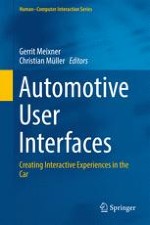2017 | OriginalPaper | Chapter
5. Design to Support Energy Management for Electric Car Drivers
Authors : Anders Lundström, Cristian Bogdan
Published in: Automotive User Interfaces
Publisher: Springer International Publishing
Activate our intelligent search to find suitable subject content or patents.
Select sections of text to find matching patents with Artificial Intelligence. powered by
Select sections of text to find additional relevant content using AI-assisted search. powered by
